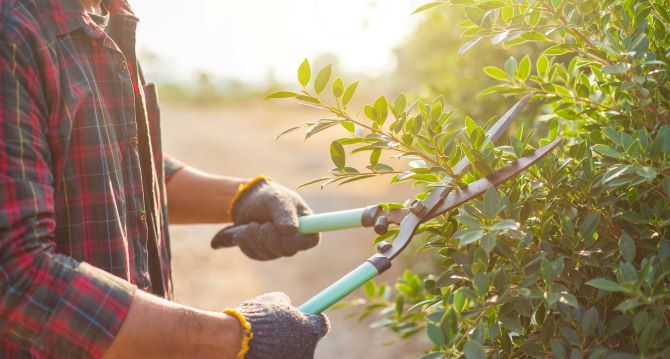Are you eager to get your garden ready for spring and summer? In this article, we tell you everything you need to know about pruning your shrubs. After reading, you will know what costs to expect, the best time to prune, which tools you need and what else to consider.
Table of contents
- How much does pruning a shrub cost?
- Why is pruning important?
- What is the best time to prune?
- Basic rules for pruning
- Tips: how to save on your pruning work
- Frequently asked questions
How much does a shrub prune cost?
If you have your shrubs pruned by a specialist, you will pay an average of £55 per hour. Besides the hourly rate, other factors also play a role in determining the price, including the size of your shrubs and the accessibility of your garden. Moreover, for efficiency and safety reasons, gardeners sometimes come in pairs for your garden maintenance. £ 300
Find the best specialist for your project and get free quotes.
Start

Why is pruning important?
It is good to prune your shrubs regularly for a number of reasons. Firstly, it keeps your garden looking nice and your shrubs in shape. Regularly pruning conifers, for instance, makes a world of difference to their appearance.
Also, regular pruning prevents overdue maintenance, which often involves high costs. After all, the more work a professional has to do, the longer he will be busy and the higher the costs will be.
What is the best time to prune?
When to prune your shrubs depends, among other things, on whether your shrubs are early-flowering or late-flowering. Early-flowering shrubs that bloom in spring, prune immediately after flowering. That way, you can enjoy the flowers first and they will then have a chance to make new buds in the summer. They will then sprout again the following spring.
Do you have a butterfly bush or hibiscus in your garden? Then you are dealing with a late-flowering plant. You prune these in March. Then they sprout again and in spring you will see new buds appear. From July, these shrubs are in full bloom.
Basic rules for pruning
If you have a small garden with simple shrubs and a green thumb, you might want to prune your shrubs yourself. Before you do, it is good to know about the following do’s and don’ts:
- Never prune when it is freezing: this is bad for your tools and pruning wounds heal worse;
- Always cut branches at an angle: That way rainwater does not stay on the pruning wound;
- Make sure you always use sharp tools;
- Try to keep and maintain the basic shape of your shrubs by following the branch from the end of the twig downwards to find side branches;
- Remove branches that are dead or growing or rubbing over each other;
- Put past new shoots and cut them back deeply to stimulate growth;
- Put away no more than one-third of your shrubs;
- Make sure your shrubs remain balanced.
Further instructions and principles
There are a few things that will help you a little further when pruning your shrubs:
- Branches grow faster if they are upright;
- Branches that droop or grow horizontally are ideal for flowers and fruit;
- If you prune a branch, then the highest remaining bud will form the strongest shoot;
- Do you think your hibiscus is too big? Then cut the highest branches in half;
- Does your butterfly bush no longer look so pretty? Prune it back to 40 centimetres in autumn. This will make your butterfly bush more resistant to frost. In spring cut it back to 25 centimetres.
The tools you need
Good tools are half the battle. As briefly mentioned earlier, it is important to at least always make sure that your tools are sharp when pruning your shrubs. This is because when you prune, you make small wounds on the branches. Sharp tools make for smooth wounds and they recover faster. What kind of tools do you need when pruning by yourself? You will go a long way with the following tools:
- A pruning shear: for medium-sized branches;
- A large pair of two-handed shears: for thicker branches;
- A pruning saw: for branches thicker than 3.5 centimetres;
- A hedge trimmer: for hedges and fine branches.
Tips: how to save on your pruning
If you want to make some savings on pruning, don’t choose the materials first. You don’t necessarily have to go for the most expensive tools, but do go for quality. It is better to think about the following saving tips first:
- Subscribe to a specialist: That way, you will end up cheaper;
- Dispose of the pruning waste yourself instead of leaving it to the gardener for a fee;
- Keep up with the pruning, so that you don’t have any overdue maintenance;
- Choose smaller and less exotic shrubs that are less maintenance-intensive;
- Choose a simple form of your shrubs, as special wishes are costly.
Find the best specialist for your project and get free quotes.
Start
Frequently asked questions
Please cut about an inch above an eye or bud that points outwards and continues to grow. This will ensure that the structure of your shrubs remains open and take into account that the branch will often die off for a while.
Although most shrubs are best pruned from March onwards, there are also shrubs that should be pruned at the beginning of autumn or in winter. Examples of these are rose bushes, grape bushes and lavender bushes.
If you don’t prune a butterfly bush, the flowers in the bush will keep shifting upwards. This is because flowers arise from new shoots. Not much is then left of the base of the shrub.